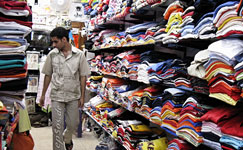Free trade area to link Cape and Cairo
By Lorraine Kearney
22 May 2015
The Tripartite Free Trade Area stretching from Cape to Cairo – which has been in
the works since 2008 – will be launched on 10 June in Sharm el-Sheikh, in Egypt.
Trade and Industry Minister Rob Davies gave the date in a media briefing ahead of
his budget vote in the National Assembly, in parliament, Cape Town, on 21 May.
The zone will stretch from Egypt to South Africa and will connect consumers in the
26-member countries of three existing trade blocs: the Common Market for Eastern
and Southern Africa (Comesa), the East African Community (EAC), and the South
African Development Community (SADC).
"The Tripartite Free Trade Area… will signal that we are on track to create a market
of over 600 million people with a combined gross domestic product [GDP] of over
$1-trillion," he said in his budget vote.
"Later in the same month, in South Africa, negotiations will be launched for the
establishment of a Continental FTA that
will embrace the entire continent – a
market of 1.3 billion people with a combined GDP of over $2-trillion."
Those negotiations will be launched at the 25th AU Summit, taking place in South
Africa from 7 to 15 June.
In announcing these moves, Davies said South Africa had been playing a prominent
role in championing developmental integration in the regional economic
communities of which it was a member, and in the African Union.
"These developments follow the extraordinary SADC Summit held last month which
approved a SADC Regional Industrialisation Strategy and Roadmap. South Africa
strongly supports regional and continental efforts to build more industrialised and
diversified economies and reduce member states' overdependence on primary
products."
Speaking to the media on the sidelines of his budget vote, Davies said South Africa
supported the T-FTA because it believed that such a zone could contribute to the
regional value chain. While
it would be launched officially next month, he admitted
there were still some "tariff schedule agreements" that needed to be finalised.
These were unpacked in his budget vote delivered to the National Council of
Provinces a day earlier, on 20 May.
"There has been a concerted effort to enhance access for South African products,
especially value-added exports in international markets. Africa remains at the
centre of our efforts, where we have been actively championing continent-wide
industrialisation and an ambitious development integration programme," he said in
explaining South Africa's involvement in the T-FTA.
"[Its] launch signifies the conclusion of negotiations on the legal instrument and will
be followed by a process to finalise negotiations on tariffs and Rules of Origin, the
key elements of a functional free trade area. This is an important milestone in the
implementation of the development integration agenda in Africa aimed at promoting
market integration, based on industrial and infrastructure development."
The African market was crucial for South Africa's industrialisation and job creation
efforts as one of the key destinations for its value-added exports, Davies explained
to the council of provinces.
The T-FTA will account for half of the membership of the African Union and 58% of
the continent's GDP, according to a statement issued following the Tripartite
Sectoral Committee of Ministers in Bujumbura, Burundi, on 25 October 2014.
"The Tripartite FTA, popularly known as the Grand Free Trade Area, will be the
largest economic bloc on the continent and the launching pad for the establishment
of the Continental Free Trade Area (CFTA) in 2017," reads part of the statement.
"It offers significant opportunities for business and investment within the Tripartite
and will act as a magnet for attracting foreign direct investment into the tripartite
region. The business
community, in particular, will benefit from an improved and
harmonised trade regime that reduces the cost of doing business."
 A man shops for clothing in Egypt. (Image: epSos, Wikimedia Commons)
A man shops for clothing in Egypt. (Image: epSos, Wikimedia Commons)
 A man shops for clothing in Egypt. (Image: epSos, Wikimedia Commons)
A man shops for clothing in Egypt. (Image: epSos, Wikimedia Commons)